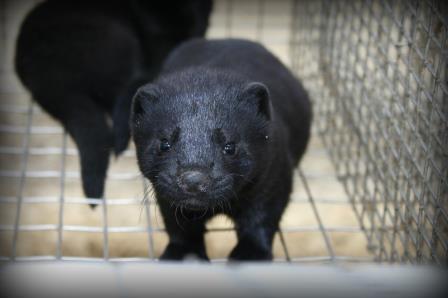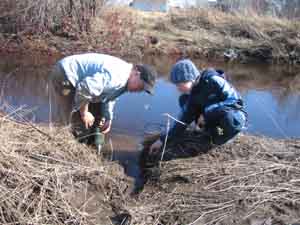In our last post, we exposed how activists lie when they claim that the World Bank condemned fur dressing as “highly polluting”.
Today we turn our “Truth-About-Fur-Detector” to another oft-repeated but equally fraudulent claim.
Activists often insist that “a coat made from wild-caught fur requires 3.5 times more energy than a synthetic coat, while a farmed-fur coat requires 15 times more energy.” (see: NOTES, below)
These “facts” are attributed to “a study by the University of Michigan” or sometimes the “Scientific Research Laboratory at Ford Motor Company”. Wow, pretty credible sources, right? Except that a quick search reveals that neither institution ever published such a study!
This report does indeed exist, although it is very old – it was published in 1979. The author, one Gregory H. Smith, is identified as an engineering graduate of Michigan U., who worked for Ford. But he prepared his report at the request of The Fund for Animals (a Michigan-based animal-rights group), “to augment its arguments for abolishing the cruelties to animals resulting from the procurement of natural animals furs for human adornment.”
The methodology of this report is equally suspect.

According to Smith, more than 90 per cent of the energy attributed to the production of a farmed mink coat is accounted for by a single item: the feed used to produce the mink pelts. Smith claims that mink feed represents 7.7 million of the 8.5 million British Thermal Units (BTUs) he calculates is required to make a fur coat. But BTUs, scientific as they may sound, don’t tell the whole story. Like the mink themselves, mink feed is organic material. Specifically, mink eat the parts of chickens, cattle, fish and other foodstuffs that we don’t eat. Mink feed, in the language of ecology, is “a renewable resource”. The petroleum used to produce poly-acrylic fake fur, by contrast, is a non-renewable resource. Comparing the energy used to produce natural mink and fake fur is comparing apples and oranges. (Or, more accurately: apples and the plastic bag you carry them home in!)

Furthermore, much of this abattoir and fish-packing waste would end up clogging land-fills if mink were not consuming it. Far from being an environmental “cost”, this recycling of wastes from our own food-production system can be seen as an environmental “credit”. (Mink also help to keep down the cost of human food, since food processors would have to pay to dispose of these wastes if mink farmers weren’t using them.)
Smith also misses the point in his analysis of wild-captured furs.
He guesstimates the amount of gasoline trappers might use touring their trap lines, heating their cabins – and even the energy required to make steel for traps that may be lost or require replacement. His numbers are arbitrary and questionable, to say the least. But, more to the point: he ignores the fact that furbearer populations would often have to be managed even if we did not use the fur – e.g., to protect property, control diseases and protect endangered species. Overpopulated beavers can flood roads, farmland, and forest habitat. Coyotes and foxes prey on livestock or the eggs (or chicks) of nesting birds; without predator control, it would be difficult to protect endangered whooping cranes or sea turtles. Raccoons and skunks spread rabies, and on it goes. Without fur sales, wildlife population control work would still have to be done, but trappers would be paid by the taxpayers – as they are in many European countries. (E.g., muskrat control in Belgium and Holland.) Again: the conservation work done by trappers can be seen as an environmental credit, rather than a cost!
Bottom line: the real wasteful BTUs expended here would seem to be in quoting this poorly researched and misleading “study”. We can only hope that Mr. Smith kept his day-job at Ford!
**************************
NOTES:
Here are a few examples where the “University of Michigan / Ford Motor Company” report is cited to claim that fur requires more energy to produce than fakes:
- “One article commonly cited by anti-fur groups is a study by the Ford Motor Company comparing the energy requirements of fur production. The study concluded that a fur coat made from wild trapped animals required 3.5 times the energy input compared to a synthetic fur coat.” From Fur is Mean by Eric Simpson, The Queens Journal, 8 November 2013.
- “According to a study at the University of Michigan, the energy needed to produce a fur coat from farmed animals is 15 times greater than that required for a fake one.” From Is ‘ethical fur’ the fashion industry’s most cynical con yet? By Danny Penman, The Daily Mail, 17 March 2011.
- “According to a study by the University of Michigan, the energy needed to produce a real fur coat from ranch-raised animal skins is 20 times that required for a fake product.” From Fur – the fake debate, The Independent, 23 November 2004.












Thank you for debunking this “study”. The continual promulgation of falsehoods by these ‘activists’ isn’t doing them any favors in the long run.
This is coming from someone who was a vegetarian for 5 years for ethical reasons. I gave it up as I think I was lacking something in my diet as I started dreaming about eating fish. I also wear leather and sheepskin, but you’re intelligently written posts have me thinking that even fur is not necessarily worse for the planet than synthetics.
And before any self-righteous geniuses triumphantly point out my you’re/your error: it was a voice-to-text transcriptional error made by my device.
Not that the lack of simple proofreading would negate my point, anyway. This is just a blog comment, not a term paper 🙂
So well written and logical, and to think the antis are still liars about everything they say’ I LOVE THE LIE WHERE ANIMALS ARE SKINNED ALIVE! These people really think the public is one mass of stupidity.Maybe some are! Fools are born sane and activists exploit them for their money. All heads of animal rights groups live the life of the rich and famous with the $$ of well intentioned foolish people.Where is that money? Well it surely is not spent feeding the hungry and injured animal, you’d be smarter supporting a local ANIMAL SHELTER and buying a natural fur product!
PETA are such sweet talking folk but they have a very high contempt for supplying truth to any debate. Here is a truth that bares their soul. Rather then pay for Kibbles,& bits, medical aid or shelter which would subtract a lot of their ill gotten money PETA kills animals at a very high rate and does the dumpster toss with the poor critters. https://townhall.com/tipsheet/cortneyobrien/2015/02/25/virginia-peta-shelter-has-a-kill-rate-of-81-percent-n1962128 Animal Rights: Virginia PETA Shelter Has a ‘Kill Rate’ of 81 Percent During last weekend’s Oscars, one particular commercial that aired featured young animals somberly saying things like, “I’ll never learn to fetch” and “I won’t ever get to play with my best friend.” Why? Because “PETA killed me.” The seemingly strange spot, produced by the Center for Consumer Freedom, was a spoof on the laughably bad Nationwide Super Bowl commercial earlier this month and was designed to expose People for the Ethical Treatment of Animals’ hypocrisy. It turns out, however, that unlike the Nationwide commercial, this anti-PETA ad is actually pretty accurate.
In a new report, it has been revealed that Virginia’s PETA shelter euthanizes a majority of the animals they bring in. Take a look at this tragic rate from the state branch of the “animal rights” organization:
According to a state report, of the 3,017 animals PETA took in in Virginia last year, 2,455 were put down. That is a kill rate of about 81 percent.
Because of these horrifying statistics, critics are demanding the PETA location be shuttered, as well as better define what it means to be an animal shelter. On Monday in Virginia’s House of Delegates, Virginia legislators passed Bill 1381, which would “seek to prevent any private shelter from practicing euthanasia.” Instead of chambers where these poor creatures go to be killed, these shelters would act more like safe adoptive homes. The law passed overwhelmingly with a vote of 95-2.
The ad from the Oscars reports that PETA has killed more than 33,000 animals since 1998. So, for all those animal rights activists who like to push the envelope with their radical demonstrations to supposedly bring awareness to animal abuse, they might want to aim those protests at their own organization.
For those interested, here was the Oscar ad in full:
Update: The Center for Consumer Freedom reached out to me to provide more information about PETA’s mistreatment of the animals it claims to protect. Here’s a snippet from a press release sent earlier this month, with comments from Will Coggin, the director of research at CCF:
PETA’s kill numbers come from the Virginia Department of Agriculture and Consumer Services (VDACS), which requires such annual disclosures to be made. Most animals don’t even get a chance: A 2010 inspection conducted by a VDACS veterinarian of animal custody records discovered that 84 percent of the animals PETA took in were killed within 24 hours.
Coggin concluded, “PETA’s so-called ‘shelter’ might as well be called a slaughterhouse. For an organization that once disgustingly compared the treatment of farm animals to the Holocaust, you’d think PETA would avoid the appearance of systematic killing. It’s time Virginia stopped the madness and shuttered PETA’s shelter of horrors for good.”.